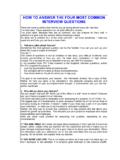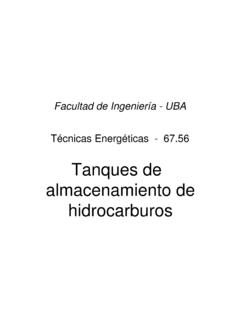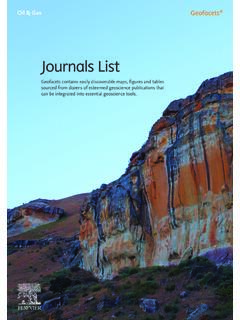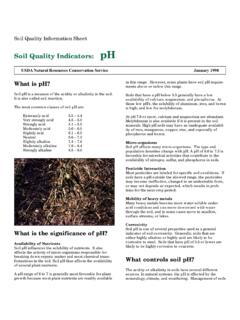Transcription of Solutions chs 1-5 - materias.fi.uba.ar
1 1 Soil Mechanics: concepts and applications 2nd edition Solutions MANUAL William Powrie This Solutions manual is made available free of charge. Details of the accompanying textbook Soil Mechanics: concepts and applications 2nd edition are on the website of the publisher and can be ordered from or phone: +44 (0) 1264 343071 First published 2004 by Spon Press, an imprint of Taylor & Francis, 2 Park Square, Milton Park, Abingdon, Oxon OX14 4RN Simultaneously published in the USA and Canada by Spon Press 270 Madison Avenue, New York, NY 10016, USA @ 2004 William Powrie All rights reserved. No part of this book may be reprinted or reproduced or utilized in any form or by any electronic, mechanical, or other means, now known or hereafter invented, including photocopying and recording, or in any information storage or retrieval system, except for the downloading and printing of a single copy from the website of the publisher, without permission in writing from the publishers.
2 Publisher's note This book has been produced from camera ready copy provided by the authors Contents Chapter 1 .. 2 Chapter 2 .. 15 Chapter 3 .. 29 Chapter 4 .. 46 Chapter 5 .. 61 Chapter 6 .. 84 See separate file Chapter 7 .. 102 See separate file Chapter 8 .. 125 See separate file Chapter 9 .. will be provided later Chapter 10 .. will be provided later Chapter 11 .. 137 See separate file 2 QUESTIONS AND Solutions : CHAPTER 1 Origins and mineralogy of soils Describe the main depositional environments and transport processes relevant to soils, and explain their influence on soil fabric and structure. Solution Use material in Section to describe and explain transport processes: water, wind, ice, ice and water depositional environment: water might be fast or slow flowing, eg upstream (fast) or downstream (slow), or ebbing floodwater (probably slow). Windborne material might be washed out of the atmosphere by rain.
3 Material can be transported either on the top of, within or below a glacier or icesheet, or by a combination of ice and meltwater (outwash streams possibly fast flowing) and perhaps deposited into a glacial lake (slow flowing). effect of transport mechanism and depositional environment on particle size soils transported by wind and water are likely to be sorted, with finer particles remaining in suspension and being transported longer distances than coarse particles. Fine particles fall out of suspension where the water velocity is low, eg deltaic and flood plain deposits. Coarse particles on a river bed are left behind as terraces when a river changes course. Sand dunes migrate due to wind action; deposits of windborne dust washed out by rain may be very lightly cemented with a delicate and potentially unstable structure (loess). Material transported purely by ice tends to be less sorted (eg boulder clay typically has a very wide range of particle size).
4 If final transport or deposition is by or through water some sorting will take place - perhaps vertically rather than horizontally, eg mixed material washed off the top of a glacier and deposited into a glacial lake will have a laminated structure as coarse material settles quickly and fine material more slowly, a pattern repeated over many seasons as the deposit accumulates. effect on particle shape materials transported by ice are likely to be more angular, and materials transported by water more rounded. Summarize the main effects of soil mineralogy on particle size and soil characteristics. Solution Use material in Section to describe and explain the effects of mineralogy and chemical structure on particle size, flakiness and shape (clay minerals tend to be softer, more sheetlike and more easily eroded/abraded to form small, platey particles) other soil characteristics including plasticity, colloidal behaviour and capacity for cation exchange (sorption) that result from the high specific surface area, the significance of surface forces and surface chemistry effects in clays Phase relationships, unit weight and calculation of effective stresses A density bottle test on a sample of dry soil gave the following results.
5 31. Mass of 50ml density bottle empty, g 2. Mass of 50ml density bottle + 20g of dry soil particles, g 3. Mass of 50ml density bottle + 20g of dry soil particles, with remainder of space in bottle filled with water, g 4. Mass of 50ml density bottle filled with water only, g Calculate the relative density (specific gravity) of the soil particles. A 1 kg sample of the same soil taken from the ground has a natural water content of 27% and occupies a total volume of litre. Determine the unit weight, the specific volume and the saturation ratio of the soil in this state. Calculate also the water content and the unit weight that the soil would have if saturated at the same specific volume, and the unit weight at the same specific volume but zero water content. Solution The particle relative density (grain specific gravity) Gs is defined as the ratio of the mass density of the soil grains to the mass density of water.
6 For a fixed volume of solid - in this case, the soil particles - the specific gravity is equal to the mass of the dry soil particles divided by the mass of water they displace. The mass of the dry soil particles is given by (m2-m1) = The mass of water displaced by the soil particles is given by (m4-m1) - (m3-m2) = ( ) - ( ) = Gs = (m2-m1)/[(m4-m1)-(m3-m2)] = ( ) ( ) = For the sample of natural soil, the unit weight is equal to the actual weight divided by the total volume, = (1kg ) ( 10-3m3) = kN/m3 The water content w = mw/ms = For the 1kg sample, we know that mw+ms = 1kg, hence ms = 1kg ms = and mw = The volume of water vw = mw/ w = 1kg/litre = The volume of solids vs = ms/ s = = The specific volume v is defined as the ratio vt/vs = v = 4 The saturation ratio is given by the volume of water divided by the total void volume, = ( - ) = Sr = If the soil were fully saturated, the volume of water would be ( - )
7 = The mass of water would be , and the water content would be wsat = The overall mass of the sample would be + = , and its unit weight ( 10-3kN/N) ( 10-3m3) sat = If the soil were dry but had the same specific (and overall) volume, the mass would be equal to the mass of solids alone, and the unit weight would be ( 10-3kN/N) ( 10-3m3) dry = kN/m3 An office block with an adjacent underground car park is to be built at a site where a 6m-thick layer of saturated clay ( = 20 kN/m3) is overlain by 4m of sands and gravels ( = 18 kN/m3). The water table is at the top of the clay layer, and pore water pressures are hydrostatic below this depth. The foundation for the office block will exert a uniform surcharge of 90 kPa at the surface of the sands and gravels. The foundation for the car park will exert a surcharge of 40 kPa at the surface of the clay, following removal by excavation of the sands and gravels.
8 Calculate the initial and final vertical total stress, pore water pressure and vertical effective stress, at the mid-depth of the clay layer, (a) beneath the office block; and (b) beneath the car park. Take the unit weight of water as Solution Initially, the stress state is the same at both locations. The vertical total stress v = (4m 18kN/m3) (for the sands and gravels) + (3m 20kN/m3) (for the clay), giving v = 132 kPa The pore water pressure u = (3m ) = kPa The vertical effective stress 'v = v - u = (132kPa - ) = kPa Finally, 5(a) Beneath the office block, the vertical total stress is increased by the surcharge of 90kPa, giving v = 132kPa + 90 kPa v = 222 kPa The pore water pressure u is unchanged, u = The vertical effective stress 'v = v - u = (222kPa - ) 'v = kPa (b) Beneath the car park, the vertical total stress is given by v = (40kPa) (surcharge) + (3m 20kPa) (for the clay) v = 100 kPa The pore water pressure u is unchanged, u = The vertical effective stress 'v = v - u = (100kPa - ) 'v = kPa For the measuring cylinder experiment described in main text Example , calculate (a) the vertical effective stress at the base of the column of sand in its loose, dry state.
9 (b) the pore water pressure and vertical effective stress at the base of the column in its loose, saturated state; (c) the pore water pressure and vertical effective stress at the base of the column in its dense, saturated state; and (d) the pore water pressure and vertical effective stress at the sand surface in the dense, saturated state. Take the unit weight of water as Solution (a) In the loose dry state, the vertical total stress is given by the unit weight of the sand the depth h. The depth of the sand is given by the volume, 1200cm3, divided by the cross-sectional area of the measuring cylinder, , giving h = Hence v = = As the sand is dry, the pore water pressure u = 0 and 'v = v = (Alternatively, the total weight of sand is 2kg 10-3kN/kg = This is spread over an area of ( ) 4 = Hence the total stress v = = kPa.) (b) In the loose, saturated state, the pore water pressure u = u = kPa 6 The vertical total stress v = = Hence the vertical effective stress 'v = v - u = - 'v = (c) In the dense, saturated state, the weights of water and soil grains above the base do not change.
10 Hence the pore water pressure and the total stress are the same as before, and so also is the effective stress: u = kPa; 'v = (d) The water level in the column does not change: as the sand is densified, it settles through the water. The new sample height h' is given by its volume, 1130cm3, divided by the cross-sectional area of the measuring cylinder, , giving h' = The depth of water above the new sample surface is therefore ( - ) = The pore water pressure at the new soil surface is u = The effective stress at the sand surface is zero. Particle size analysis and soil filters A sieve analysis on a sample of initial total mass 294g gave the following results: Sieve size, mm Mass retained, g 0 0 30 39 28 28 16 11 A sedimentation test on the 117 g of soil collected in the pan at the base of the sieve stack gave: Size, m <2 2-6 6-15 15-30 30-63 % of pan sample 0 48 29 14 9 Plot the particle size distribution curve and classify the soil using the system given in Table Determine the D10 particle size and the uniformity coefficient U, and comment on the grading curve.












